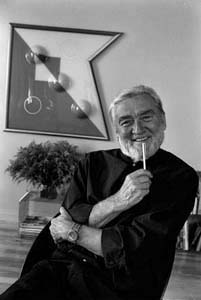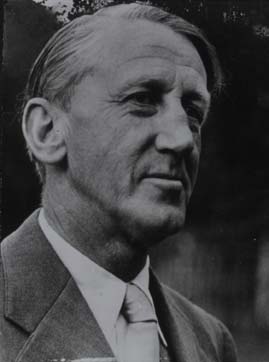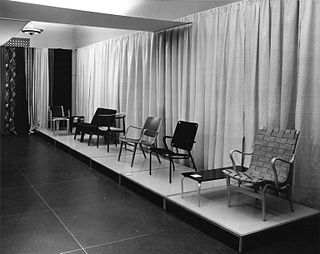
Arne Emil Jacobsen, Hon. FAIA was a Danish architect and furniture designer. He is remembered for his contribution to architectural functionalism and for the worldwide success he enjoyed with simple well-designed chairs.

The culture of Denmark has a rich artistic and scientific heritage. The fairy tales of Hans Christian Andersen (1805–1875), the philosophical essays of Søren Kierkegaard (1813–1855), the short stories of Karen Blixen, penname Isak Dinesen, (1885–1962), the plays of Ludvig Holberg (1684–1754), modern authors such as Herman Bang and Nobel laureate Henrik Pontoppidan and the dense, aphoristic poetry of Piet Hein (1905–1996), have earned international recognition, as have the symphonies of Carl Nielsen (1865–1931). From the mid-1990s, Danish films have attracted international attention, especially those associated with Dogme 95 like those of Lars Von Trier. Denmark has had a strong tradition of movie making and Carl Theodor Dreyer has been recognised as one of the world's greatest film directors. The astronomical discoveries of Tycho Brahe (1546–1601), Ludwig A. Colding's (1815–1888) neglected articulation of the principle of conservation of energy, and the foundational contributions to atomic physics of Niels Bohr (1885–1962); in this century Lene Vestergaard Hau in quantum physics involving the stopping of light, advances in nano-technology, and contributions to the understanding of Bose-Einstein Condensates, demonstrate the range and endurance of Danish scientific achievement.
Poul Kjærholm (1929–1980) was a Danish designer. Born in Østervrå, Denmark, Kjærholm began his career as a cabinetmaker's apprentice with Gronbech in 1948, attending the Danish School of Arts and Crafts in Copenhagen in 1952. In 1953, he married Hanne Kjærholm who became a successful architect. While working as a designer, he also became an educator continuing studies with Prof. Erik Herløw and Prof. Palle Suenson.
Hans Jørgensen Wegner was a Danish furniture designer. His work, along with a concerted effort from several of his manufacturers, contributed to the international popularity of mid-century Danish design. His style is often described as Organic Functionality, a modernist school with emphasis on functionality. This school of thought arose primarily in Scandinavian countries with contributions by Poul Henningsen, Alvar Aalto, and Arne Jacobsen.

Verner Panton is considered one of Denmark's most influential 20th-century furniture and interior designers. During his career, he created innovative and futuristic designs in a variety of materials, especially plastics, and in vibrant and exotic colors. His style was very "1960s" but regained popularity at the end of the 20th century. As of 2004, Panton's best-known furniture models are still in production.

In architecture, functionalism is the principle that buildings should be designed based solely on their purpose and function. An international functionalist architecture movement emerged in the wake of World War I, as part of the wave of Modernism. Its ideas were largely inspired by a desire to build a new and better world for the people, as broadly and strongly expressed by the social and political movements of Europe after the extremely devastating world war. In this respect, functionalist architecture is often linked with the ideas of socialism and modern humanism.

Kaare Klint was a Danish architect and furniture designer, known as the father of modern Danish furniture design. His style was epitomized by clean, pure lines, use of the best materials of his time and superb craftsmanship.

Scandinavian design is a design movement characterized by simplicity, minimalism and functionality that emerged in the early 20th century, and subsequently flourished in the 1950s throughout the five Nordic countries: Denmark, Finland, Norway, Sweden, and Iceland.

Danish modern is a style of minimalist furniture and housewares from Denmark associated with the Danish design movement. In the 1920s, Kaare Klint embraced the principles of Bauhaus modernism in furniture design, creating clean, pure lines based on an understanding of classical furniture craftsmanship coupled with careful research into materials, proportions, and the requirements of the human body.

The Bellevue Teatret is a theatre in Klampenborg at the northern outskirts of Copenhagen, Denmark. Opened in 1936 to the design of Arne Jacobsen, the building is considered one of his most important architectural works and exemplar of Danish functionalism. The theatre is part of a scheme also including the adjoining Bellevue Beach and residential block and was, at the time, seen as a manifestation of "the dream of the modern lifestyle".
Komplot Design is a design studio based in Copenhagen, Denmark. It was founded in 1987 by Danish architect Poul Christiansen and Russian-born designer Boris Berlin. The company works within the fields of industrial, graphic and furniture design.
Fritz Hansen, also known as Republic of Fritz Hansen, is a Danish furniture design company. Designers who have worked for Fritz Hansen include Arne Jacobsen (1902–1971), Poul Kjærholm (1929–1980), Hans J. Wegner (1914–2007) and Piet Hein (1905–1996). Fritz Hansen also collaborates with contemporary furniture architects including Hiromichi Konno, Cecilie Manz, and Kasper Salto.

Børge Mogensen, was a Danish furniture designer.

Stelling House is a building on Gammeltorv in the centre of Copenhagen, Denmark. Completed in 1937, it was designed as an office building and retail store for the A. Stelling paint company by Arne Jacobsen who took pains to have it blend in with the older buildings which surround it.
Jørgen Gammelgaard (1938–1991) was a Danish furniture designer who also designed lamps and silverware.

Poul M. Volther was a Danish furniture designer who is remembered above all for his iconic Corona Chair. He succeeded Børge Mogensen as artistic director of FDB Møbler in 1950.

The Panton Chair is an S-shaped plastic chair created by the Danish designer Verner Panton in the 1960s. The world's first moulded plastic chair, it is considered to be one of the masterpieces of Danish design. The chair was included in the 2006 Danish Culture Canon.
Carl Hansen & Søn is a family-owned Danish furniture company based on the island of Funen. Carl Hansen & Søn is the company behind many classical furniture designs by leading figures of the Danish modern movement but the company is also collaborating with contemporary designers. Knud Erik Hansen, its current owner and CEO, is the grandson of the founder.
FDB Møbler is a Danish furniture company established in 1942. It was formerly a subsidiary of FDB. Børge Mogensen served as the design studio manager and many of his designs are sold by the company. Mogensen was succeeded Poul M. Volther (1950–55), Ejvind A. Johansson (1956–58), and Jørgen Bækmark (1958–67).
Palle Suenson was a Danish modernist architect. He was the son of Professor Edouard Suenson, engineer, and of Henriette Benedicte Hartmann.
















